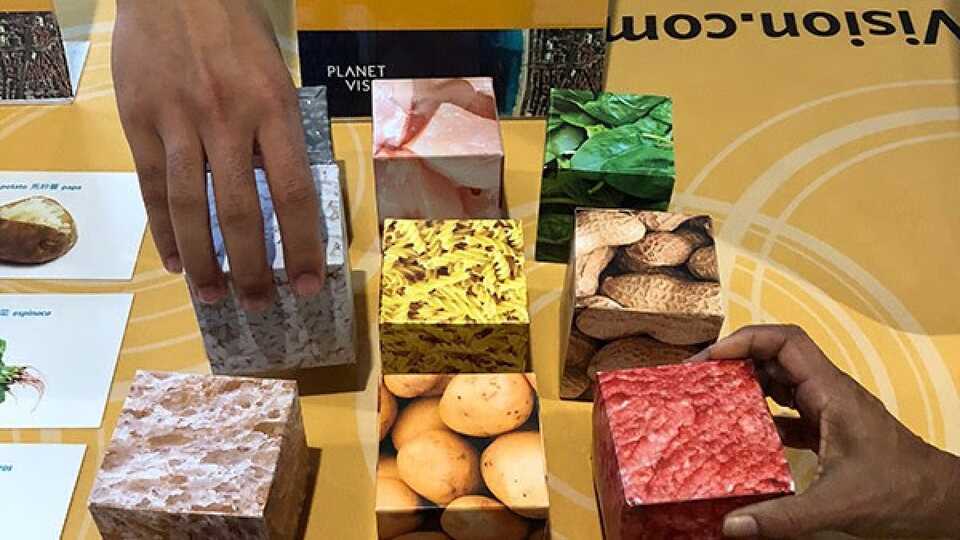Essential Question: How does our food impact the environment?
Duration: 5-10 minutes as a demonstration; 1 class period for a student activity
Age Level: Associated conversations can be tailored for age groups from 5th grade through adults.

Use the Carbon Café food cubes to initiate conversation about making better food choices for the health of our environment, through developing an understanding of relative carbon footprints of various foods. While we designed this activity to work with museum guests who stop by for a facilitated discussion, you can easily adapt it for use in your classroom, learning garden, or nature center!
Essential Question: How does our food impact the environment?
Duration: 5-10 minutes as a demonstration; 1 class period for a student activity
Age Level: Associated conversations can be tailored for age groups from 5th grade through adults.
Note: Making these materials and practicing to facilitate demonstrations for others can also be a learning experience for students.
Each box can be filled with these weights. Use ratios as appropriate, depending on the size of your boxes.
Item Carbon Weight (g)
Spinach 11
Potato 18
Wheat bread 49
Noodles 49
Black beans 66
Rice 97
Peanuts 165
Egg 301
Chicken 429
Pork 585
Cheese 831
Beef 2,250
Note: Methane and Nitrous Oxide greenhouse gases are represented as Carbon Dioxide equivalents in the total Carbon Footprints (“Carbon Weight”) above.
Why Do We Care?
What we eat and how we grow food has a bigger impact on the planet’s landscapes, water resources, and climate than anything else we do.
Impact Story:
Agriculture already uses up to 40% of our planet’s land area, drives 70% of our freshwater withdrawals worldwide, and produces over one-quarter of our greenhouse gas emissions -- mainly through deforestation, methane emissions from cattle and rice fields, and nitrous oxide emissions from fertilizer overuse. It also drives species extinctions and causes the greatest ecological damage to land and water. There is no landscape on the planet that hasn’t felt our impact, in large part due to agricultural activity.
Different amounts of energy and resources go into growing and producing food. Some foods require more resources and produce more waste than others and therefore have a bigger environmental impact. Measuring food’s carbon footprint is one way to understand its environmental effect. Understanding this relationship can help us make better food choices that benefit the health of our environment.
Interact with the Cubes!
The Carbon Café cubes reinforce concepts through tactile interactions. Weighted cubes indicate the relative carbon footprints from growing, processing, transporting, and producing the food.
Use the Carbon Café food cubes to initiate conversation about making better food choices for the health of our environment, through developing an understanding of relative carbon footprints of various foods.
Key Messages:
Carbon dioxide is a greenhouse gas that is a natural and integral part of our environment. It is released as a natural byproduct of respiration and combustion. But human activity— increased energy demands for industrial activity and food production—has caused carbon dioxide levels in Earth’s atmosphere to increase dramatically. As increasing concentrations in the atmosphere, carbon dioxide and other greenhouse gases play a key role in our changing climate and its resulting environmental effects.
Growing food results in emissions of carbon dioxide (from deforestation, farm machinery, fertilizer production), methane (from cow burps and rice production), and nitrous oxide (from fertilizer applications). Nitrous oxide and methane are more powerful greenhouse gases than carbon dioxide. The different types of greenhouse gases are represented in the food cubes as carbon dioxide equivalents.
As students pick up each cube they will notice that animal products have a greater carbon footprint than plants. One reason for this is that animals require food in the form of plants (grains, corn, and other feed which also have a carbon footprint!). This adds to the animal carbon footprint. It is interesting that 75% of all farmland used to grow food is used to raise animals or produce animal feed.
The students will quickly notice that beef is the heaviest cube. Cattle are ruminants, with special multi-chambered stomachs that allow them to digest grass, but ruminants also release a lot of methane (through burps), which is a greenhouse gas 35 times worse for the climate than carbon dioxide. Chickens and Pigs are not ruminants so they don’t release very much methane. Beef has a carbon footprint 5x greater than chicken (20x greater than beans).

Learn tips to avoid wasting food and other simple ways to improve your impact on the environment with Your Plan, Your Planet, a tool from Google and the Academy.
These science-based tips offer ways to make a difference by focusing on the three areas where humans have the most impact: food, water, and energy. You'll also learn about the Circular Economy to extend the life of your stuff.